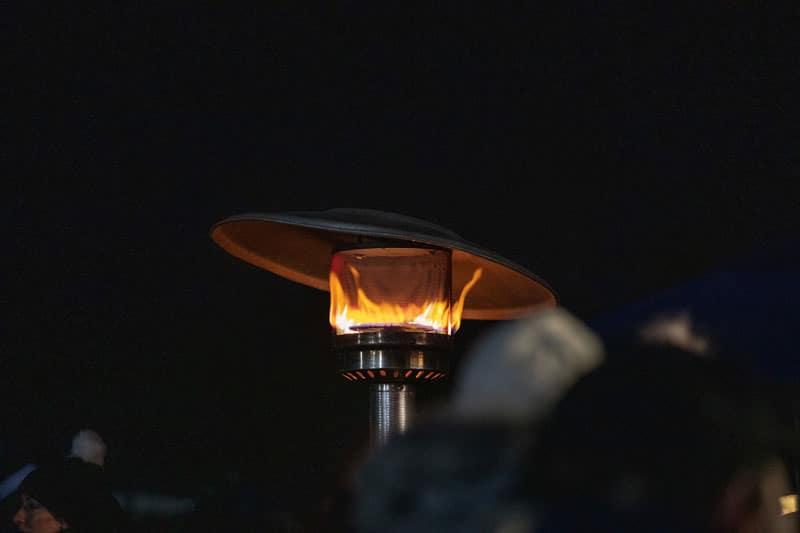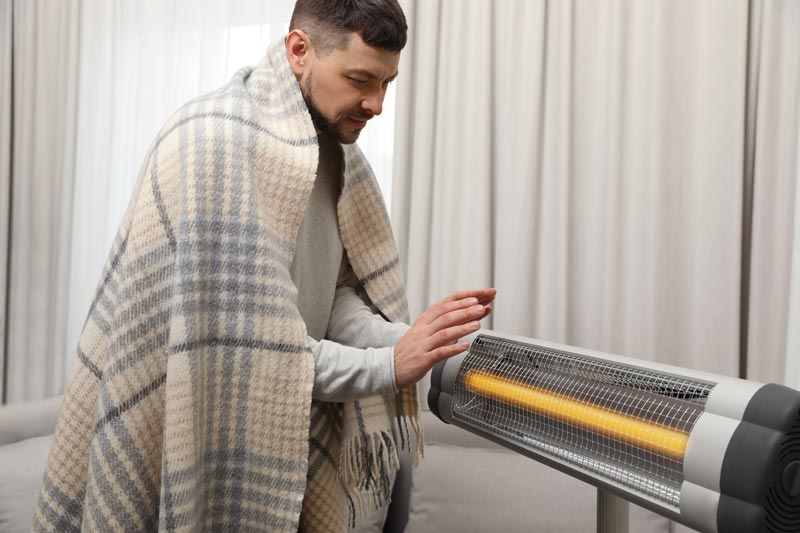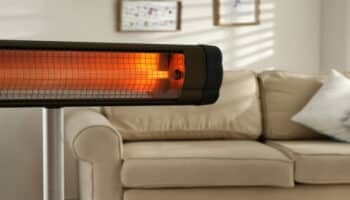Are you stuck trying to decide between a gas and an infrared heater?
You’ve come to the right place for answers!
Whether you live in a freezing area or simply love feeling cozy at home while doing your favorite activity, it’s undeniable that owning a heater can make your life easier.
One would think that having several options would be a good thing, but sometimes, it can be overwhelming. If you’re here, you’re likely not sure about how gas and infrared heaters can work for you, and what are the advantages of owning each one.
But, don’t worry. In this article, you’ll learn more about the pros and cons of gas and infrared heaters, so you can make the right choice based on what you find more valuable.
Let’s go through them together!
Infrared vs Gas Heater Pros & Cons
The main difference between infrared and gas heaters is the way they provide heat. Infrared heaters can heat specific objects and people. Gas heaters, on the other hand, can warm an entire room.
However, there are other characteristics that you might want to take into consideration before buying an infrared or gas heater.
This is why, below, I’ve prepared a list including the pros and cons of each model.
Pros & Cons of Infrared Heaters:
| Pros | Cons |
| Cheaper to run than gas heaters | Outlet-dependent |
| Very safe to use | More expensive than gas heaters |
| More efficient heating | |
| Wind-resistant |
Pros & Cons of Gas Heaters:
| Pros | Cons |
| Highly portable | Fire hazard |
| Fast heating | Vulnerable to wind |
| Canister-dependent | |
5 Key Factors to Consider
As you can see, each model boasts amazing features that you could take advantage of during cold seasons. However, this is not enough to help drive your decision, we must look into more specific aspects.
#1 Price
This, along with lifespan, is usually what most people care about from the start. When it comes to either model, you’ll be happy to know that they’re both in similar price ranges.
Sure, depending on how many bells and whistles you want, you can get a heater in every price tier. But when compared equally, there’s not a big difference. If anything, infrared heaters are a tad more expensive, but nothing out of proportion.
That being said, whenever you’re buying an appliance, you should not only consider the price tag but also the collateral costs that come with it. While gas heaters use propane, infrared heaters use electricity, so you should take into account what the Kilowatt per hour price is in your area before making a decision.
You could find a great deal on the most wonderful infrared heater, but if electricity is very expensive in your area, you might end up having to pay a fortune every month to run it.
#2 Safety
Sadly, very few people consider this factor when looking into buying a new heater.
Whether you’re part of a big family or live on your own, you want to make sure that the heater you buy won’t be a hazard, right? Here’s where infrared heaters start taking the lead, as, other than the heat they produce, they represent very little danger to you or others.

Unfortunately, the same can’t be said for propane models. These not only need fire but also highly-pressurized gas canisters to function and generate heat, which makes them more dangerous than infrared ones.
Moreover, propane heaters are not only prone to gas leaks but also to explosions if the canister is handled wrong.
Having said that, there are several countermeasures and components built into them to prevent most accidents. However, if you live with small children or pets that are likely to tip the heater over, it might be a good idea to go infrared.
#3 Portability
If you ask me, one of the most important features that a heater can have is portability. Being able to use your appliance in your garden on Monday, and in your room on Wednesday, can be very useful.
This is where propane heaters take the cake.
Since they require nothing more than a gas canister to function, they offer a wide range of mobility and independence. Something infrared models cannot do.
Usually, the latter need to be connected to a wall outlet or to your home’s wiring in the case of wall-mounted units. This requires you to commit to placing them in a specific area or having to make certain decisions.
If you like using your heater in the garden, where power sources are scarce, buying an infrared model might put you in an uncomfortable position since you might have to choose between charging your phone or staying warm.
#4 Heating Efficiency
Let’s face it, running either model will increase your monthly expenses, there’s no way around that. That being said, one model can use energy much more efficiently than the other, which will cut down the costs of running it.
I’m talking, of course, about infrared heaters.
Infrared heaters are almost 100% efficient, which means they transform almost all the electricity they draw from the outlet, into heat.
You can think of it as pouring water into a glass from a jar. If all the water that left the jar ended up inside the glass, you would have 100% pouring efficiency, and any droplets that fell outside the container would be lost efficiency.

As you can imagine, the more efficient your heater is, the better it will be at heating your living spaces’ while using less energy.
Now, I’m not saying that propane heaters are not efficient, but they certainly can’t compete with their infrared counterparts. And the reason lies with the way in which the heat.
You see, while infrared heaters use infrared waves to heat people and objects directly, gas heaters heat up the surrounding air. This results in some of the energy (propane gas) consumed being lost in the process.
It varies from model to model, but if I had to give a ballpark figure, I’d say propane heaters are about 80% efficient.
#5 Lifespan
Believe it or not, this will be determined more by your user habits, than by any other factor.
In theory, both gas and infrared heaters should last about the same. The difference lies in what each one requires to be kept in optimal condition.
On one hand, infrared heaters are plug-and-play. You will never have to pay much attention to them unless something’s failing inside them. On the other hand, gas models need to be constantly maintained, cleaned, and cleared of obstructions, as they have several internal components that can fail as a result of neglect.
Moreover, gas models require you to change their canister often in order to function and provide you with the desired results. Whereas infrared models just need you to pay the bills on time every month.
This is where a lot of people make up their minds and choose one over the other. If you know you’re someone who can easily forget to give your appliance adequate maintenance and check its components frequently, go infrared.
Regardless of how long a manufacturer might claim their heater to last, it will be very difficult to have your unit last as long as you neglect it.
Summary: Infrared or Gas Heaters?
As you’ve learned above, there’s no single answer to this question. You want to go for the heater that solves the most problems for you and makes your life easier. If you know you live in an area where electricity costs are very high, go propane.
Provided that you live in a home with small children and pets, go infrared to prevent accidents and fire hazards.
The purpose of this article is to provide you with useful information that could help drive your decision. However, it should not be your only source. Try browsing some online marketplaces and looking at customer reviews to get a clearer idea of what you should expect.
Moreover, if you know someone who owns either one of these models, it would be a great idea to ask them what their experience has been. After all, word of mouth can’t be beaten.
Conclusion
Choosing between different models of an appliance can be overwhelming. With so many options out there, it can be very easy to lose track of what features are important, and what factors should be taken into account.
Luckily, I hope I’ve provided you with enough information and knowledge to understand and choose the heater that is best for you. Make sure to remember to consider the collateral costs of each one, and think long-term to determine whether portability is something you’ll need.
Thank you so much for sticking with me all the way to the end. If you found this article helpful, why not keep the learning going through our other incredible resources below?
I wish you all the best!
— Craig.
Frequently Asked Questions
How to Pick the Right Size Heater?
That’s a little tough to answer, as you’ll have to check your particular living spaces.
Heating capacity is typically measured in BTUs, or British Thermal Units. A BTU is a measurement equivalent to the heat necessary to increase the temperature of 1 lb (0.45 kg) of water by 1 degree Fahrenheit.
Most heaters are rated in BTUs, so you might want to try Google searching the recommended BTUs for specific square feet to know what size heater you require.
Are Gas Heaters Safe for Indoor Use?
Only if there’s proper ventilation.
As I stated earlier in the article, gas heaters are not 100% efficient, so some of the gas from the canister will not burn off. If you use this type of heater indoors without ventilation, you could become intoxicated from the residual fumes.
How to Keep an Infrared Heater in Good Condition?
As you learned before, infrared heaters are pretty easy to maintain. If anything, I’d recommend cleaning the reflector (when it’s completely cool and the appliance is unplugged) with a soft rag and occasionally double-checking that the power cord is undamaged.
Can Infrared Heaters Cause a Fire?
Technically, yes. But it would be very difficult.
Since infrared heaters don’t use a flame, it’s a lot harder for them to cause a fire as opposed to their gas counterparts, which are more of a fire hazard.
That being said, if a fire was started by one of these appliances, it would sooner come from a damaged power cord short-circuiting than from the reflector itself.
Generally, in the event of an accident, infrared heaters will give you a nasty burn, but won’t start an actual fire unless very specific conditions are met.







